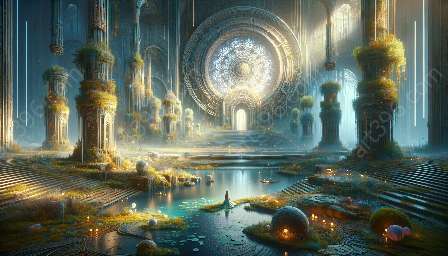Concept art is the visual representation of a concept or idea, often used in the development of video games, movies, and other forms of media. Special effects in concept art play a crucial role in bringing these concepts to life, and lighting and shadow are essential elements that contribute to the creation of stunning visual effects.
The Role of Lighting
Lighting is a fundamental aspect in creating special effects in concept art. It sets the mood, defines the atmosphere, and directs the viewer's attention to specific areas of the artwork. Whether it's a dramatic spotlight illuminating a character or a soft, diffused glow creating an otherworldly environment, the use of lighting can drastically alter the overall tone and impact of the artwork.
Artists often use various lighting techniques, such as high contrast lighting, rim lighting, and ambient lighting, to enhance the visual impact of their concept art. By carefully considering the placement and intensity of light sources, artists can create depth, drama, and realism within their compositions.
The Impact of Shadow
Shadow is equally important in contributing to special effects in concept art. Shadows add depth, dimension, and visual interest to the artwork. They help define the form of objects and characters, create contrast, and add a sense of realism to the scenes.
Artists use different types of shadows, including cast shadows, form shadows, and attached shadows, to convey the materiality and three-dimensionality of their concepts. By manipulating the shape and opacity of shadows, artists can evoke a sense of mystery, tension, or intrigue in their artwork, ultimately enhancing the overall impact of the special effects.
Creating Atmosphere and Depth
Through the strategic use of lighting and shadow, artists can achieve remarkable special effects in concept art that contribute to the creation of immersive worlds and captivating scenarios. By carefully crafting the interplay between light and dark, artists can establish the mood of a scene, emphasize focal points, and evoke emotional responses from the audience.
Moreover, lighting and shadow play a crucial role in creating spatial depth within the artwork. By manipulating the distribution of light and shadow, artists can sculpt the environment, define the contours of objects, and establish convincing spatial relationships between elements within the composition. This dimensional quality brings the concept art to life, making it visually engaging and believable.
Emphasizing Visual Effects
Special effects in concept art often rely on the skillful use of lighting and shadow to accentuate the visual impact of the artwork. Whether it's the ethereal glow of magical spells, the ominous silhouette of towering creatures, or the dynamic interplay of light and shadow in futuristic cityscapes, these effects are made possible by the deliberate manipulation of lighting and shadow to create striking visual compositions.
Artists skillfully leverage lighting and shadow to produce dazzling visual effects that captivate the viewer, conveying a sense of wonder, excitement, and narrative depth. The interplay between these elements allows for the creation of awe-inspiring atmospheres, seamless integration of fantastical elements, and the portrayal of epic encounters, all of which contribute to the immersive and cinematic nature of concept art.
Conclusion
Lighting and shadow are indispensable tools in the creation of special effects in concept art. Their strategic use not only enhances visual appeal but also contributes to the narrative, emotional impact, and believability of the depicted concepts. By understanding the nuances of lighting and shadow, artists can bring their visions to life with compelling special effects, captivating audiences and serving as an integral part of the concept art creation process.

